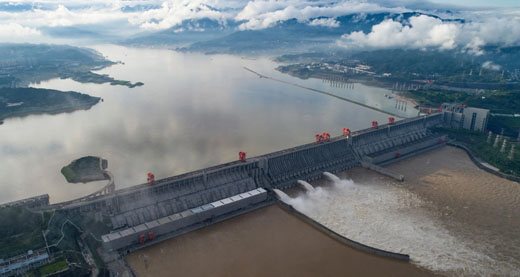FPI / July 27, 2020
Analysis by Jason Orestes
“Made in China” already doesn’t have the strongest connotation associated with it, and it appears this may even apply to mainland Chinese infrastructure.
China has upped spending on dams in the last several years to combat flooding, namely on the Yangtze River: the longest river in Asia.

It began construction on the Three Gorges in 1994, a project that required more than one million people to relocate. It’s a massive creation, measuring 1.25 miles long and is the world’s largest hydroelectric dam/facility; it’s currently the only thing standing in the way of unleashing several hundred nuclear bombs worth of energy on Hubei province, of which Wuhan is the capital. And its structural integrity is in question.
As if Wuhan hasn’t been the epicenter of enough human suffering lately, this would vastly exceed the destruction the Wuhan coronavirus has already wrought on the region. Massive rains that typically abate in July have produced the most torrential downpours since 1998 and have caused the Yangstze to overflow, resulting in over $10 billion in damages, 23 million displaced, and 141 deaths.
This pales in comparison to what will happen if the dam breaks. The city of Yichang and its four million inhabitants would be gone within a half hour, with Wuhan and its ten million citizens in danger of being eradicated. For context: when we dropped the atomic bombs on Japan, about 225,000 were killed.
Fears over the gargantuan creation imploding have become a real black swan reality after satellite imagery of the dam from 2009 to 2019 showed it is bending under immense pressure. While this kind of concern isn’t entirely new whenever the region gets heavy sustained rains, the Chinese Communist Party (CCP) commenting publicly on it has fostered more credence to the claims the dam is in danger.
China’s Minister of Water Resources Ye Jinanchun hinted at a “black swan event” after commenting that the coming rainfall would “exceed existing flood control”. As the rain continued, smaller dams began to crack, with a dam in Guangxi failing and flooding surrounding villages in the process. This was an event not reported by state-controlled Chinese media, deepening concerns that if there was a problem with Three Gorges it would be concealed not only from the world but from China’s own citizens who are directly in harm’s path.
Beijing’s official messaging is, of course, to deny any issue at all with Three Gorges. When pressed on the incontrovertible evidence of the dam’s compromised structure, they did concede it had “deformed slightly”, while reiterating this still posed no risk.
China has been prioritizing water conservation projects on lakes and rivers, however this comes after decades of ignoring this infrastructure. About 96% of the 94,000 dams along China’s rivers were constructed in the 1950s and 1960s. If these smaller, far less reliable dikes and dams were to give, their ability to divert flood waters can have significant effects on major dams like Three Gorges.
What is likely the world’s largest slab of concrete was built with robustness in mind; it’s presumed capable of being able to survive nuclear attacks. Barring an outlier event that no one can predict, it’s almost impossible the dam will crumble entirely. However we don’t need the worst-case scenario for real destruction to occur if only parts of the dam give way.
The mighty Three Gorges has a max capacity water level of 594 feet, meaning any volume over that has water spilling over the dam. It’s warning level is 476 feet and its maximum level is around 574 feet. Right now, the dam water levels sit at 522 feet; the risks here are very real. This is a potential hazard that will make covid seem like the good old days in China if catastrophe strikes, and will cause a severe crisis of confidence of China’s own citizens in its government.
Jason Orestes (@market_noises) is a former Wall Street financial analyst who focuses on contemporary political developments affecting economics, markets, and culture. His commentary can be found on Washington Examiner, TheStreet, MSN Money, RealClearMarkets, and RealClearPolitics.
FPI, Free Press International
